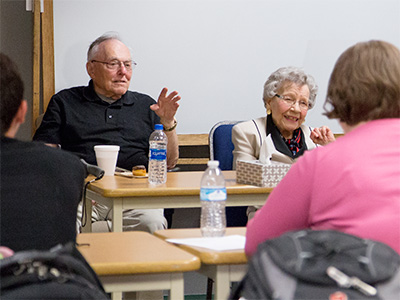
Veterans of World War II, U.S. Marine Peggy Cavin and Air Force Aviator Sheldon Beigel speak to History Professor John Kemp's class on March 14.
Two veterans of World War II, Peggy Cavin and Sheldon Beigel, stood in front of History Professor John Kemp’s class at Truckee Meadows Community College on March 14, answering a barrage of questions about their experiences.
Airman Beigel walks with a cane due to his war injuries. Peggy Cavin is 5 feet 0 inches tall—but has the 7-foot determination of a center basketball player.
U.S. Marine and Patriot Peggy Cavin
“There was nobody in my family to represent the military—it had to be me,” she said. “So, I signed up, but I didn’t pass.”
She was too short.
“So I waited around a while and they lowered the standard from 5 feet 4 inches to five feet,” Cavin added with a coy smile.
She entered the U.S. Marine Corps during World War II, went to cooks and bakers school, and was stationed at Marine Corps Air Station Miramar Base in San Diego, where she served from 1943 for more than two years until the war concluded in 1945.
During an outing, Cavin and a few friends were hiking. They saw a group of male Marines coming down the hill and stopped to chat. They wanted to take a picture of the women soldiers.
“Our rifles were just about as big as we were,” she said.
One of the men asked her for her name and phone number, and she did something she’d never before done in her life.
“I gave him a fictitious name,” she said. “Then I gave him my name … you see, I had a nametag on my jacket.”
World War II ended in 1945. They were married about three weeks after he came back from active duty abroad.
“We were married 67 years, so I guess it was a good choice,” Peggy said.
Technical Sergeant and Airman Sheldon Beigel
Sheldon Beigel grew up in the low hills of western Massachusetts, working at his family’s dairy farm. He learned to fish, hunt, and track when he was a boy. He enlisted in the Air Force at 18, following in the military tradition of his father who served as an infantryman in World War I.
He started as a Technical Sergeant, becoming an aviator in the air crew, flying combat missions in the 8th Air Force based in England.
“War, I’m telling you straightforward, it’s not romantic like you read in the books,” he said. “It’s awful, it’s disgraceful. War is a terrible thing.”
Beigel has several medals.
“War is very serious, we do not take that lightly,” he said. “At no point do I brag about the medals, at no point do I brag about the kills, no way do I brag about any of the cities that I bombed.”
He remembers two bombing missions over Berlin in 1944.
“War is work, sweat, and death—it stinks,” he said.
For most of the missions, he served as the bombardier on a B-17, a plane that has been called the “Flying Fortress”. He said that an airman doesn’t simply jump into the cockpit, that there are first two to three hours of prepping the plane.
At 3 a.m., the charge of quarters (CQ) awakens the airmen, saying “Wake up eagle, you’re off.” Then at a briefing, they would be given instructions on the day’s target. Breakfast would be before or after the briefing. They started flying across the English Channel toward Germany at about 8 or 9 a.m. He flew missions with between 200 to 1,000 airplanes.
Beigel flew 32 combat missions until his plane was shot down, was “caught”. The shrapnel blew up behind him in the cabin and wounded the two pilots, navigator, and Sheldon.
The surviving crewmembers crash-landed somewhere in a freshly plowed farm field in northern France.
Sheldon credits his childhood tracking skills with saving their lives.
In order for him to move his crew from the wreckage to an area of thick brush for hiding, he told his men not to step in the peaks of the furrowed earth. Instead, they should step over the peaks, and proceed diagonally across the rows toward the bushes. That way, the Germans couldn’t track them easily. They made it to the brush and hid there waiting.
Finally, British troops came. But the crew was dressed in flyer’s overalls, not in air force uniforms, so the Brits wouldn’t know them as the Allies.
He remembered some slang from London and called it out to identify themselves to the British forces, but at first they weren’t convinced. So he tried good old American terms with a Massachusetts accent.
“We’re yanks—we’re all yanks,” he shouted.
That persuaded them.
After the war, he enrolled at Case Western Reserve University in 1947. Beigel completed a bachelor’s degree from Cleveland College in 1949, majoring in biology and journalism, and minoring in English. He went on to work for the military industrial complex (MIC), and retired when he was 88 years old.
History Comes to Life in Class
Students in Professor Kemp’s class sat very still as they listened to Peggy and Sheldon. There were quite a few questions after their talk, including a question from a student whose family member also served during World War II. Several TMCC student veterans, and Veterans Resource Center Coordinator, Zack Totans also attended the once-in-a-lifetime presentation by members of the Greatest Generation.
For more information about the History Department at TMCC, please call 775-673-7132.






